Abstract
1. Subjects' ability to detect movements imposed at the elbow during active flexion was measured. Movements of three different angular velocities (0.04, 0.4 and 4.4 deg/s) were applied to the arm while subjects maintained one of two force levels of active flexion. The threshold magnitudes for detection of the direction of imposed movement were found. 2. All thresholds were very small. At the lowest velocity of movement the average threshold was 0.13 deg and no subject had a threshold of greater than 0.3 deg. This contrasts with thresholds of over 2 deg measured in a previous study when the muscles about the joint were relaxed. Thresholds decreased further with increasing velocity of movement. 3. No difference was found between the two levels of contraction of the elbow flexors. However, extension (stretch of the contracting muscle) and flexion thresholds were calculated separately, and smaller extensions than flexions could be detected. 4. These findings indicate that conscious detection of imposed movements is greatly enhanced during active muscle contraction. Movements which cause unloading of the contracting agonist, as well as movements which result in stretch, are more easily detected than when the muscle is contracting. The discussion focuses on possible mechanisms for this enhancement.
Full text
PDF
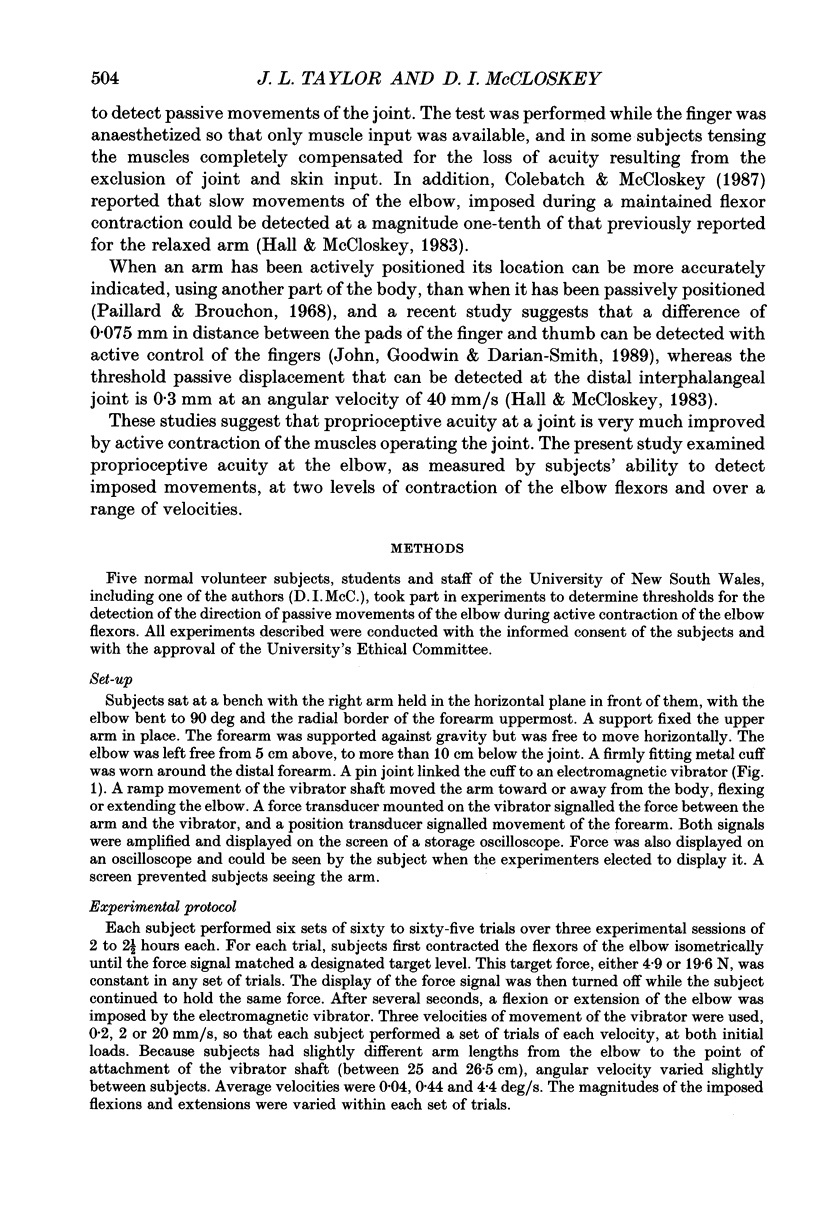
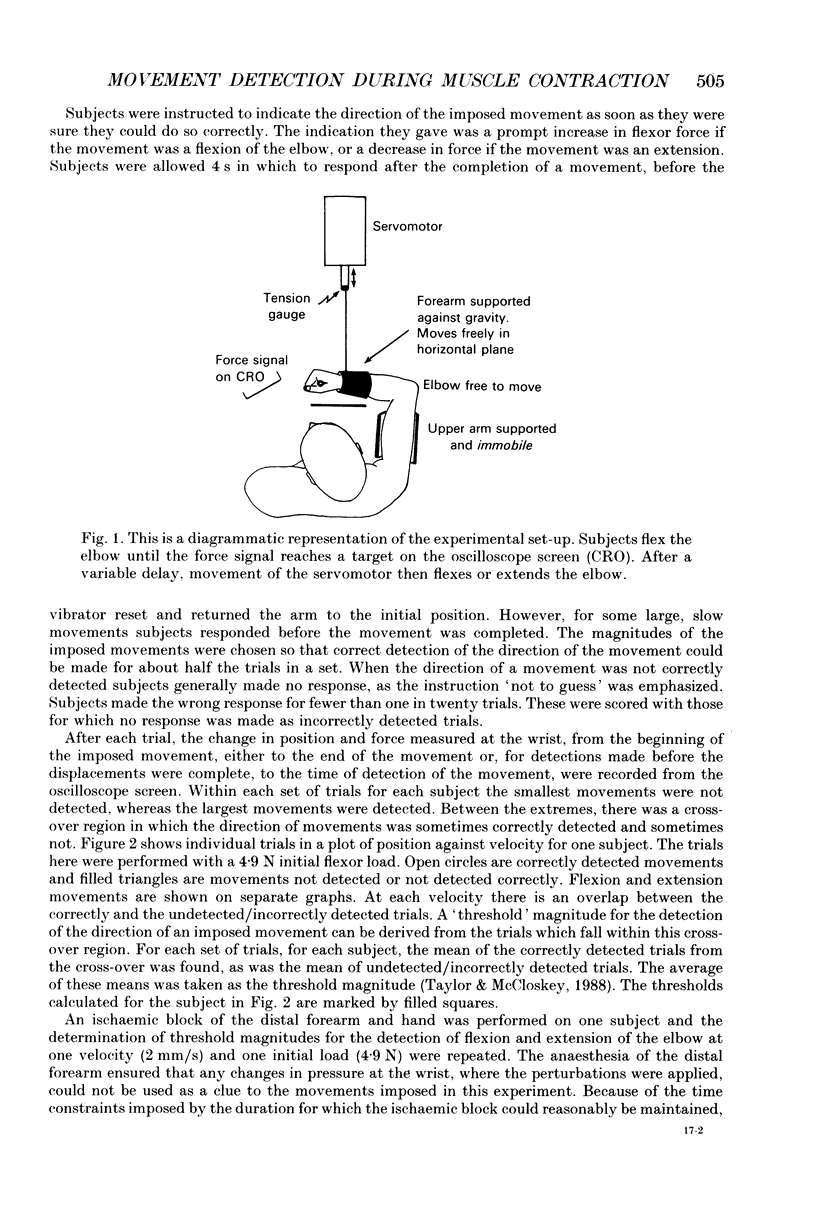
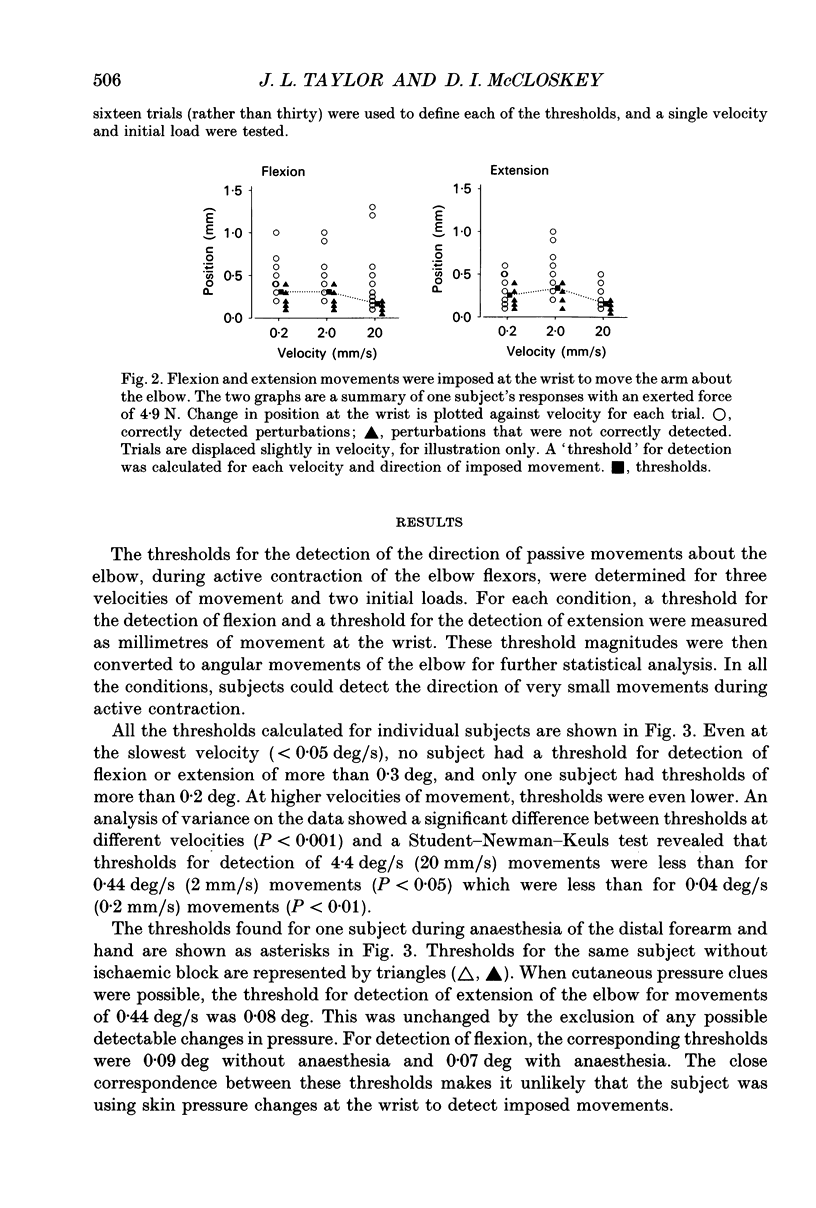
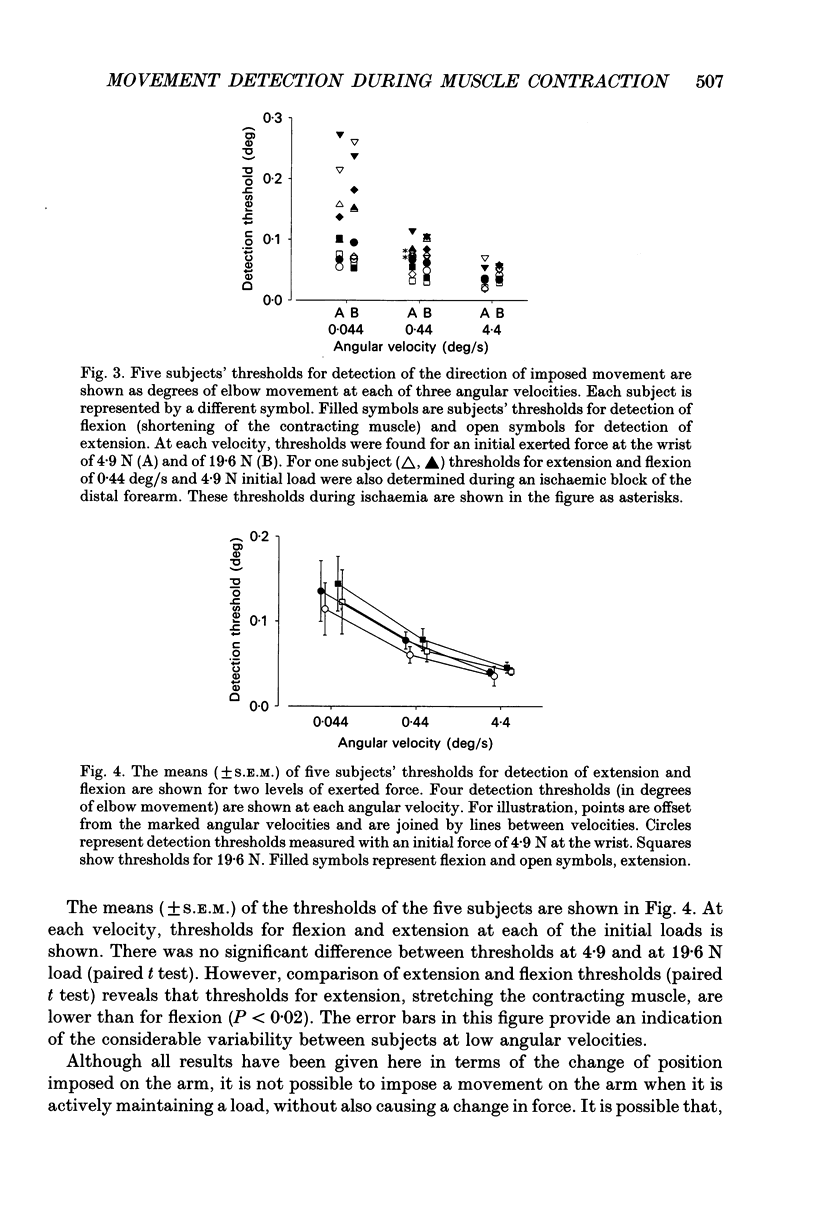
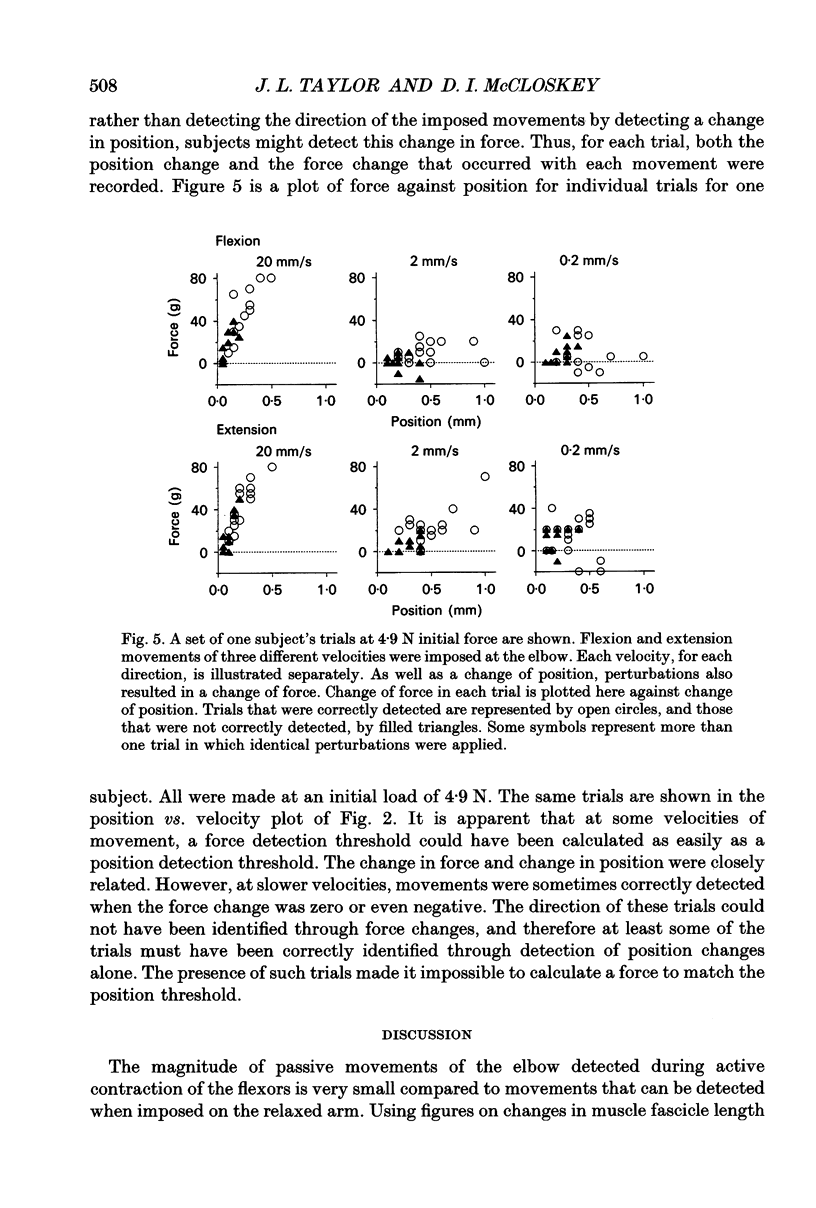
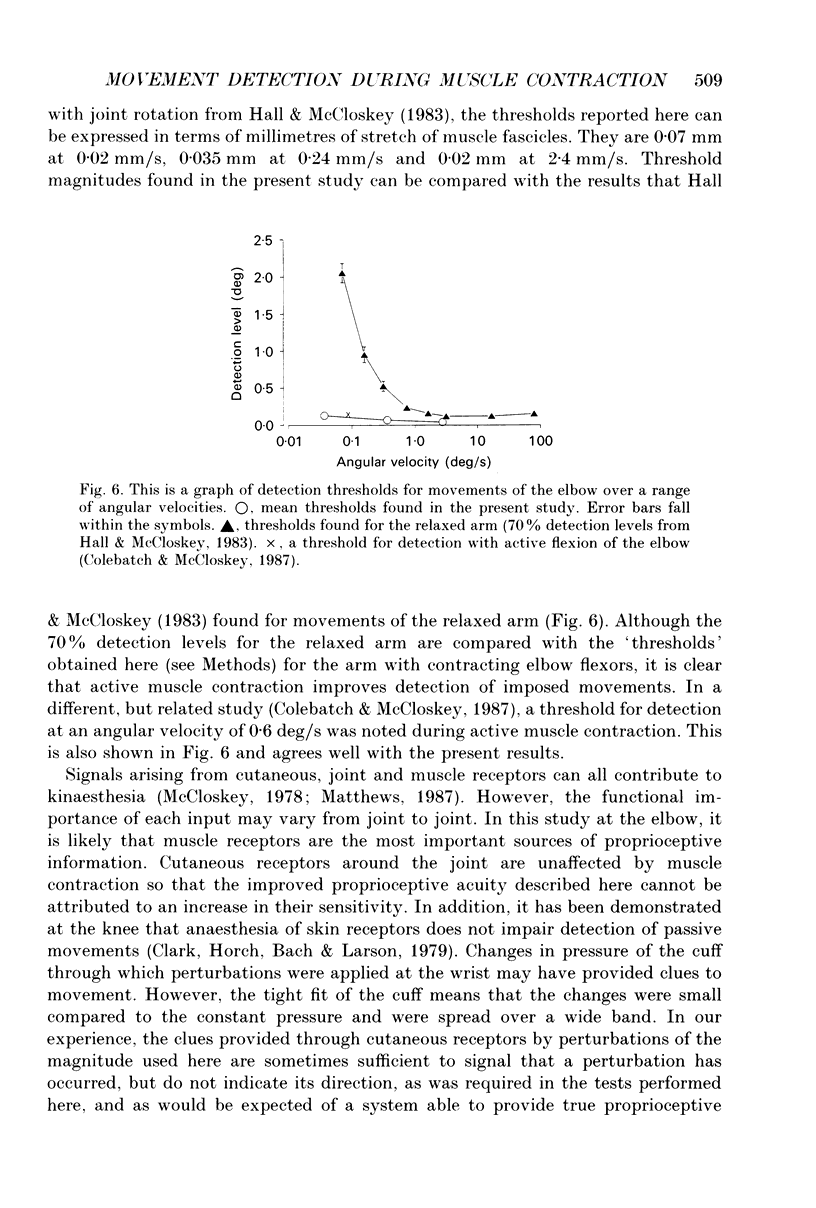
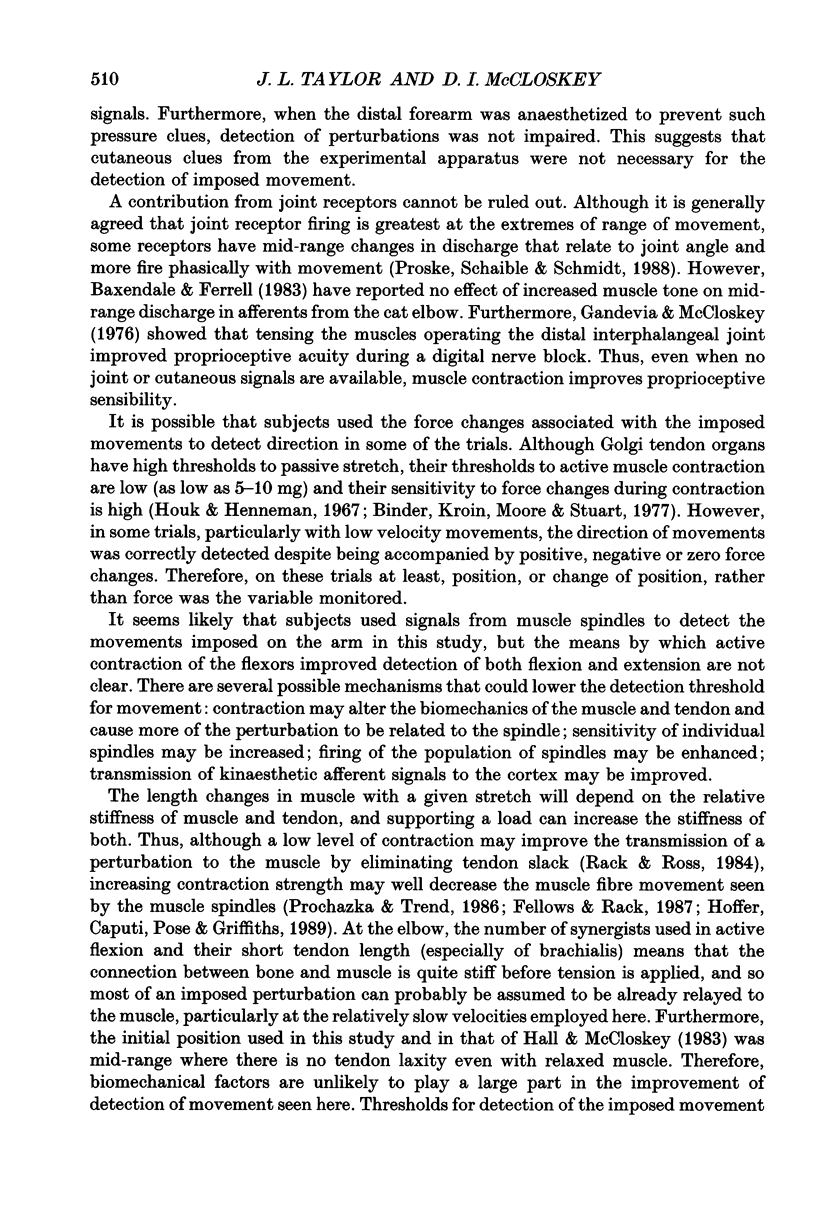
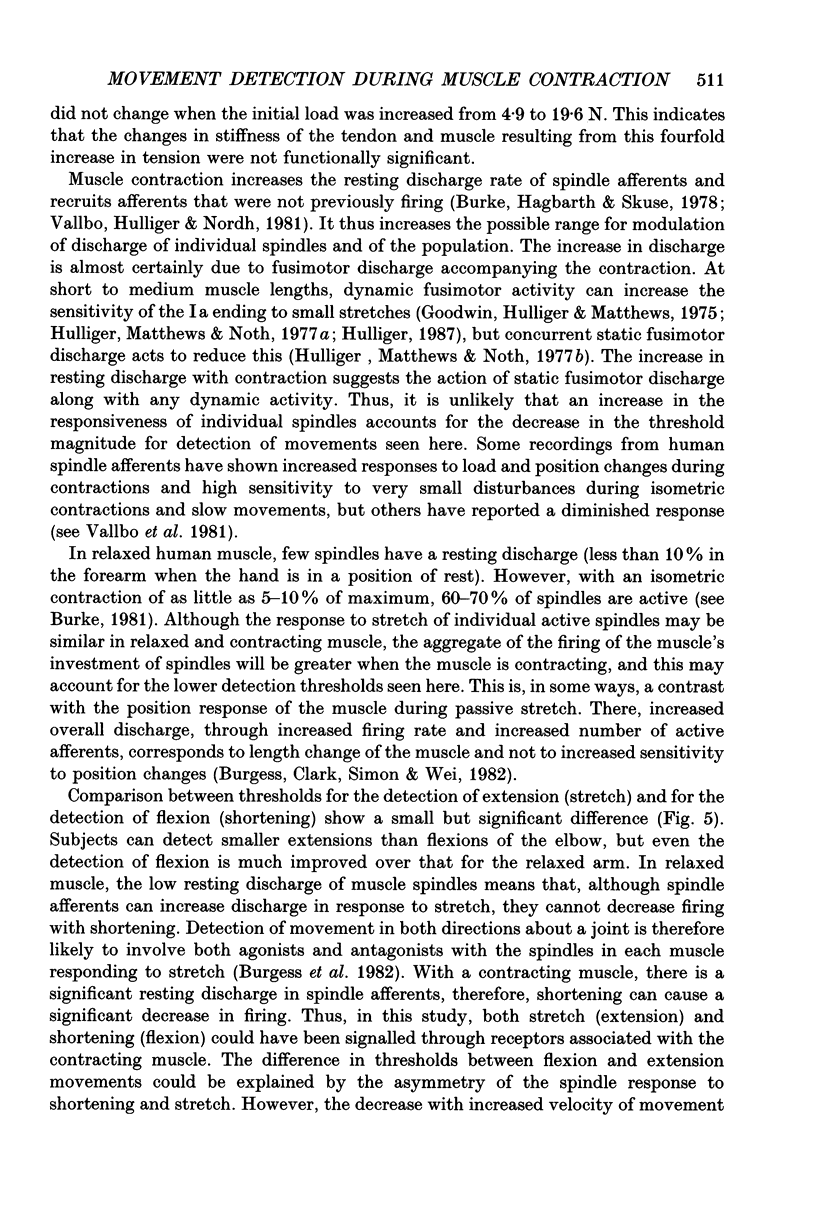
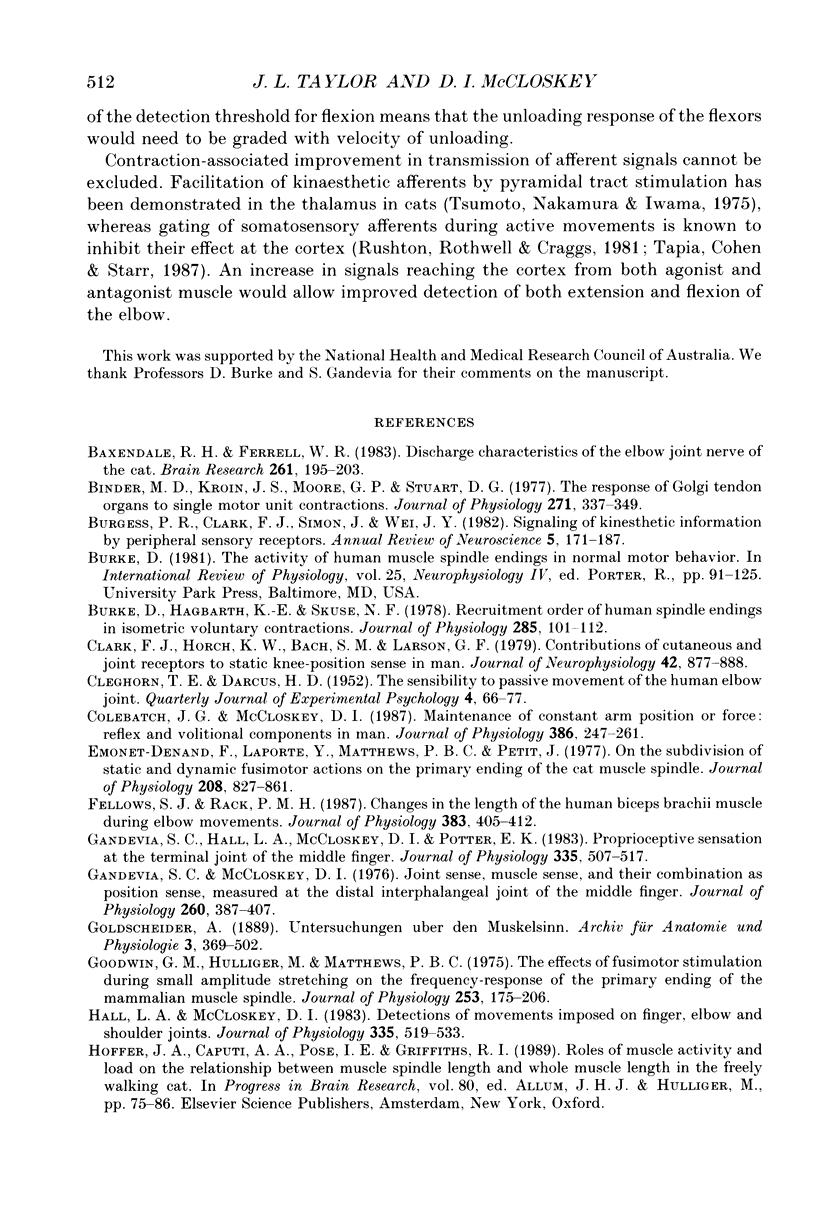
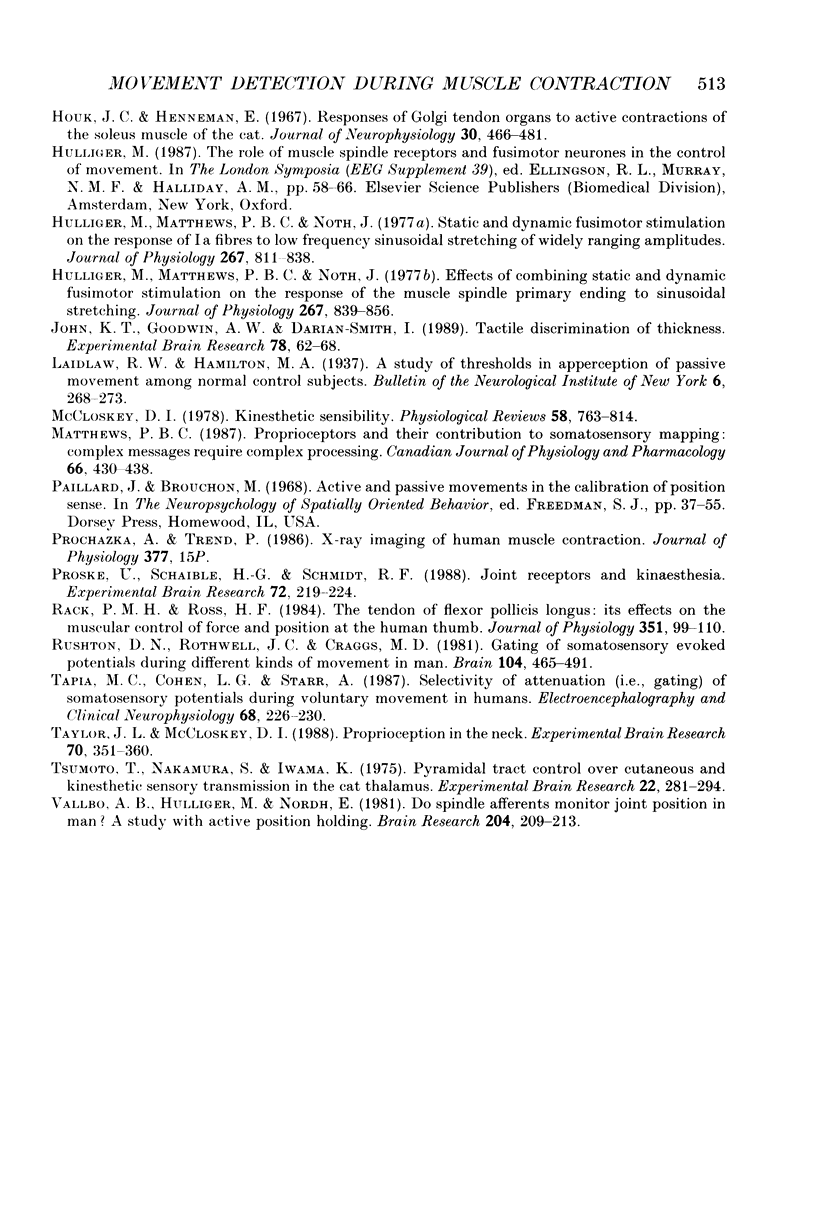
Selected References
These references are in PubMed. This may not be the complete list of references from this article.
- Baxendale R. H., Ferrell W. R. Discharge characteristics of the elbow joint nerve of the cat. Brain Res. 1983 Feb 21;261(2):195–203. doi: 10.1016/0006-8993(83)90623-6. [DOI] [PubMed] [Google Scholar]
- Binder M. D., Kroin J. S., Moore G. P., Stuart D. G. The response of Golgi tendon organs to single motor unit contractions. J Physiol. 1977 Oct;271(2):337–349. doi: 10.1113/jphysiol.1977.sp012003. [DOI] [PMC free article] [PubMed] [Google Scholar]
- Boyd C. A., Shennan D. B. Human placental sulphate transport: studies on chorionic trophoblast brush border membrane vesicles. J Physiol. 1986 Aug;377:15–24. doi: 10.1113/jphysiol.1986.sp016173. [DOI] [PMC free article] [PubMed] [Google Scholar]
- Burgess P. R., Wei J. Y., Clark F. J., Simon J. Signaling of kinesthetic information by peripheral sensory receptors. Annu Rev Neurosci. 1982;5:171–187. doi: 10.1146/annurev.ne.05.030182.001131. [DOI] [PubMed] [Google Scholar]
- Burke D., Hagbarth K. E., Skuse N. F. Recruitment order of human spindle endings in isometric voluntary contractions. J Physiol. 1978 Dec;285:101–112. doi: 10.1113/jphysiol.1978.sp012560. [DOI] [PMC free article] [PubMed] [Google Scholar]
- Clark F. J., Horch K. W., Bach S. M., Larson G. F. Contributions of cutaneous and joint receptors to static knee-position sense in man. J Neurophysiol. 1979 May;42(3):877–888. doi: 10.1152/jn.1979.42.3.877. [DOI] [PubMed] [Google Scholar]
- Colebatch J. G., McCloskey D. I. Maintenance of constant arm position or force: reflex and volitional components in man. J Physiol. 1987 May;386:247–261. doi: 10.1113/jphysiol.1987.sp016532. [DOI] [PMC free article] [PubMed] [Google Scholar]
- Emonet-Dénand F., Laporte Y., Matthews P. B., Petit J. On the subdivision of static and dynamic fusimotor actions on the primary ending of the cat muscle spindle. J Physiol. 1977 Jul;268(3):827–861. doi: 10.1113/jphysiol.1977.sp011884. [DOI] [PMC free article] [PubMed] [Google Scholar]
- Fellows S. J., Rack P. M. Changes in the length of the human biceps brachii muscle during elbow movements. J Physiol. 1987 Feb;383:405–412. doi: 10.1113/jphysiol.1987.sp016416. [DOI] [PMC free article] [PubMed] [Google Scholar]
- Gandevia S. C., Hall L. A., McCloskey D. I., Potter E. K. Proprioceptive sensation at the terminal joint of the middle finger. J Physiol. 1983 Feb;335:507–517. doi: 10.1113/jphysiol.1983.sp014547. [DOI] [PMC free article] [PubMed] [Google Scholar]
- Gandevia S. C., McCloskey D. I. Joint sense, muscle sense, and their combination as position sense, measured at the distal interphalangeal joint of the middle finger. J Physiol. 1976 Sep;260(2):387–407. doi: 10.1113/jphysiol.1976.sp011521. [DOI] [PMC free article] [PubMed] [Google Scholar]
- Goodwin G. M., Hulliger M., Matthews P. B. The effects of fusimotor stimulation during small amplitude stretching on the frequency-response of the primary ending of the mammalian muscle spindle. J Physiol. 1975 Dec;253(1):175–206. doi: 10.1113/jphysiol.1975.sp011186. [DOI] [PMC free article] [PubMed] [Google Scholar]
- Hall L. A., McCloskey D. I. Detections of movements imposed on finger, elbow and shoulder joints. J Physiol. 1983 Feb;335:519–533. doi: 10.1113/jphysiol.1983.sp014548. [DOI] [PMC free article] [PubMed] [Google Scholar]
- Houk J., Henneman E. Responses of Golgi tendon organs to active contractions of the soleus muscle of the cat. J Neurophysiol. 1967 May;30(3):466–481. doi: 10.1152/jn.1967.30.3.466. [DOI] [PubMed] [Google Scholar]
- Hulliger M., Matthews P. B., Noth J. Effects of combining static and dynamic fusimotor stimulation on the response of the muscle spindle primary ending to sinusoidal stretching. J Physiol. 1977 Jun;267(3):839–856. doi: 10.1113/jphysiol.1977.sp011840. [DOI] [PMC free article] [PubMed] [Google Scholar]
- Hulliger M., Matthews P. B., Noth J. Static and dynamic fusimotor action on the response of Ia fibres to low frequency sinusoidal stretching of widely ranging amplitude. J Physiol. 1977 Jun;267(3):811–838. doi: 10.1113/jphysiol.1977.sp011839. [DOI] [PMC free article] [PubMed] [Google Scholar]
- John K. T., Goodwin A. W., Darian-Smith I. Tactile discrimination of thickness. Exp Brain Res. 1989;78(1):62–68. doi: 10.1007/BF00230687. [DOI] [PubMed] [Google Scholar]
- Matthews P. B. Proprioceptors and their contribution to somatosensory mapping: complex messages require complex processing. Can J Physiol Pharmacol. 1988 Apr;66(4):430–438. doi: 10.1139/y88-073. [DOI] [PubMed] [Google Scholar]
- Proske U., Schaible H. G., Schmidt R. F. Joint receptors and kinaesthesia. Exp Brain Res. 1988;72(2):219–224. doi: 10.1007/BF00250245. [DOI] [PubMed] [Google Scholar]
- Rack P. M., Ross H. F. The tendon of flexor pollicis longus: its effects on the muscular control of force and position at the human thumb. J Physiol. 1984 Jun;351:99–110. doi: 10.1113/jphysiol.1984.sp015235. [DOI] [PMC free article] [PubMed] [Google Scholar]
- Rushton D. N., Rothwell J. C., Craggs M. D. Gating of somatosensory evoked potentials during different kinds of movement in man. Brain. 1981 Sep;104(3):465–491. doi: 10.1093/brain/104.3.465. [DOI] [PubMed] [Google Scholar]
- Tapia M. C., Cohen L. G., Starr A. Selectivity of attenuation (i.e., gating) of somatosensory potentials during voluntary movement in humans. Electroencephalogr Clin Neurophysiol. 1987 May;68(3):226–230. doi: 10.1016/0168-5597(87)90031-1. [DOI] [PubMed] [Google Scholar]
- Taylor J. L., McCloskey D. I. Proprioception in the neck. Exp Brain Res. 1988;70(2):351–360. doi: 10.1007/BF00248360. [DOI] [PubMed] [Google Scholar]
- Tsumoto T., Nakamura S., Iwama K. Pyramidal tract control over cutaneous and kinesthetic sensory transmission in the cat thalamus. Exp Brain Res. 1975 Mar 27;22(3):281–294. doi: 10.1007/BF00234770. [DOI] [PubMed] [Google Scholar]
- Vallbo A. B., Hulliger M., Nordh E. Do spindle afferents monitor joint position in man? A study with active position holding. Brain Res. 1981 Jan 5;204(1):209–213. doi: 10.1016/0006-8993(81)90666-1. [DOI] [PubMed] [Google Scholar]


